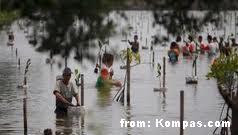Jakarta as the capital and metropolitan city has the advantage of having a location in the coastal area. Most of the coastal areas originally consisted of marsh and mangrove forest. The old ex-Batavia city was expanded from surrounding the old harbor in the north southward. But in the course of the time, most people seemed to prefer living in hinterland rather than the coastal area. They were receding from the old ex-Batavia coastal areas and developing the residential area in the southern part of the city. The old area was almost abandoned leaving the old buildings and infrastructure almost untouched, in which the slum areas grew in the surrounding of the old harbor.
However, this situation has changed after the Ancol Dreamland park was developed in the 1980s, when some properties and residential areas started to be developed nearby the park as the areas became no longer “remote”.
Several large residential areas, among other Pantai Indah Kapuk (PIK), were developed after the issuance of Presidential Decree No. 52/1995 on the reclamation of the coastal area. Under this decree, the developers were given the permit to re-claim 800 hectares of the mangrove areas to be the site of a residential area. The reclamation had caused public protest and certain NGOs and noted figures sued the city government at the state administrative court. The protest, however, did not stop the reclamation and the building construction.
The decree gave effect to the reduction of the mangrove forest along the bay of Jakarta which was originally part of the city lung. This disadvantage of losing the city greenery area was compensated with other areas in Sukabumi and Seribu Islands which, alas, were far from the original forest site.
The decrease in the mangrove forest resulted in many problems. The ecosystem of the area became seriously hampered, the abrasion of coastal areas was intensified, many houses of the fishermen and the toll road connecting the city with the international airport were frequently inundated.
To cope with those problems, the City Government launched the program to plant 3 million mangrove seedlings along with the swampy lands in the north coast of 35 kilometers long to make green belt at those flood-prone areas. One of the mangrove forests which has been preserved so far was Muara Angke. It is now the sanctuary of 90 special birds, some of which are vulnerable to the extinction. The place becomes safer for those species to stay and become the exemplary model for the reforestation.
Just recently, Jakarta Governor Fauzi Bowo together with the delegation consisting of governors and mayors from different countries attending the Asian-European Meeting (ASEM) planted 5000 mangrove seedlings at the Kapuk Indah mangrove forest. As a symbolic gesture, the Jakarta governor accompanied by Berlin and Vientiane city mayors planted the mangrove seedling demonstrating the participant governors’ commitment for the preservation of the environment and implementation of sustainable development.
Die Herren Gouverneure ich danke Ihnen sehr!




No comments:
Post a Comment